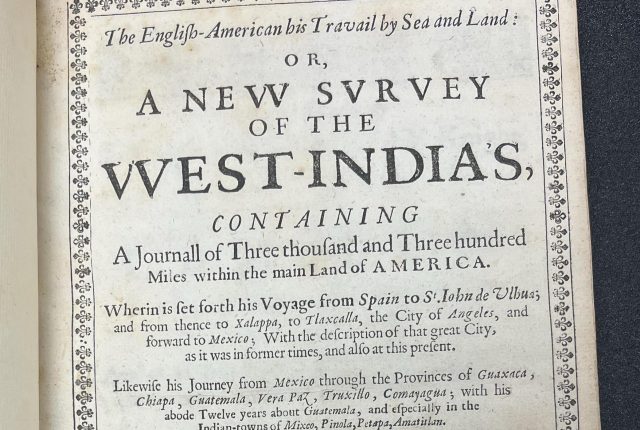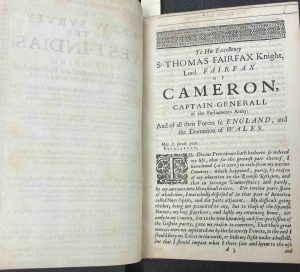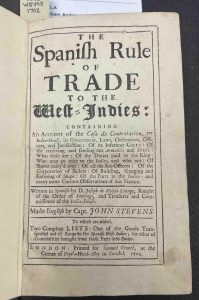
During my time as an Ahmanson-Getty Postdoctoral Fellow at the Clark, I embarked on the process of revising my doctoral dissertation into an academic monograph. My work focuses on the Spanish port of Cartagena de Indias, in modern-day Colombia, and studies how sailors, bureaucrats, and free and enslaved laborers adapted to wider changes in the Atlantic economy. To understand the political and commercial situation of the Caribbean in the seventeenth century, I use, in conjunction with archival sources, many printed narratives, like that of Thomas Gage, an English friar who traveled around the Spanish Americas in the late 1630s and later converted to Anglicanism. Gage described meeting several English prisoners in the fortified city of Cartagena. The prisoners came from the Puritan colony of Providence Island which, Gage remarked, was seen by the Spanish as “the den of thieves and pirates… threatening the galleons and their King’s yearly and mighty treasure.”
The Clark’s collection of early modern books allowed me to analyze English translations of works in other languages like Monsieur de Pointi’s expedition to Cartagena, a 1699 translation of the French account of the sack of the city in 1697 which, like Gage’s work, showed the English public the weaknesses of the Spanish military defenses. Another English attempt at understanding the Spanish empire can be found in the 1702 publication of The Spanish rule of trade to the West-Indies, an abridged translation of Norte de la Contratación de las Indias Occidentales (1672) by Spanish jurist José de Veitia Linaje. This later book tried to make sense of the Spanish commercial laws and regulations that, after almost two centuries of transatlantic circulation, had become inefficient and confusing.


In October 2024, I presented some preliminary results of my research during the first conference of the Early Global Caribbean Core Program. My paper (“Between Two Asientos: Forgotten Spanish Caribbean Slave-Trading Networks, 1640–1660”) presented new evidence about direct slaving voyages between West Africa and the Spanish Caribbean during a period in which the trade in enslaved Africans was carried out by small investors and individual adventurers, instead of the large monopoly contracts (known as Asientos) that were more common in other periods. The opportunity to receive feedback and comments from several experts in the field was a great addition to my project.
Finally, my time at the Clark gave me the opportunity to revise an article for publication in an academic journal. In “The Last Mediterranean Galleys of the Caribbean: Maritime Captivity and Labor Regimes in Cartagena de Indias (1578-1631),” which will appear in the Journal of Early Modern History later in 2025, I explore the use of Mediterranean oared-galley squads in late sixteenth- and early seventeenth-century Cartagena, showing how galleys combined coerced, enslaved, and waged labor in the Caribbean region. Galleys had occupied a special place in the European punitive imagination for a long time, as shown in The memoirs of a Protestant, condemned to the galleys of France, for his religion by Jean Marteilhe, and other similar books and pamphlets.
-Leonardo Moreno-Álvarez, 2024–25 Ahmanson-Getty Postdoctoral Fellow

